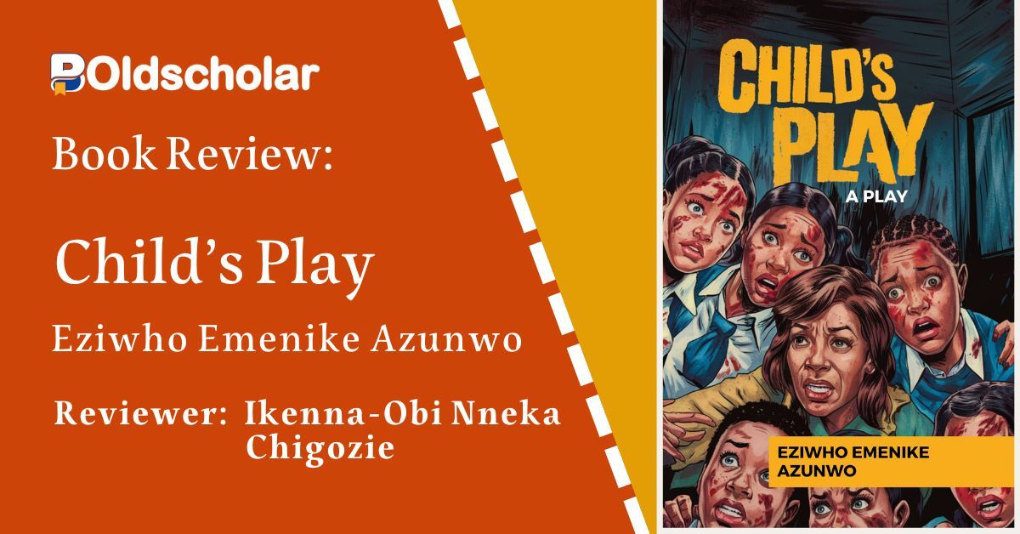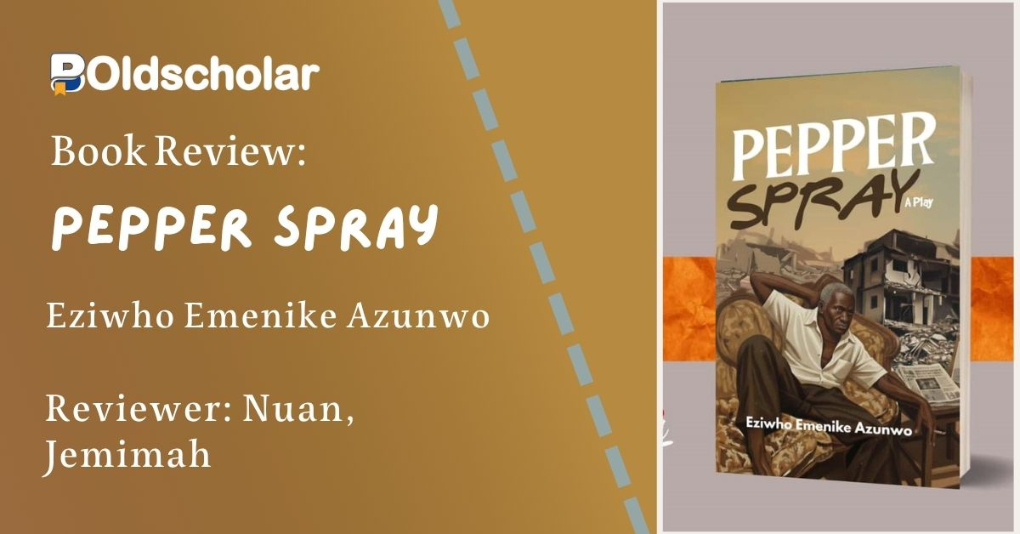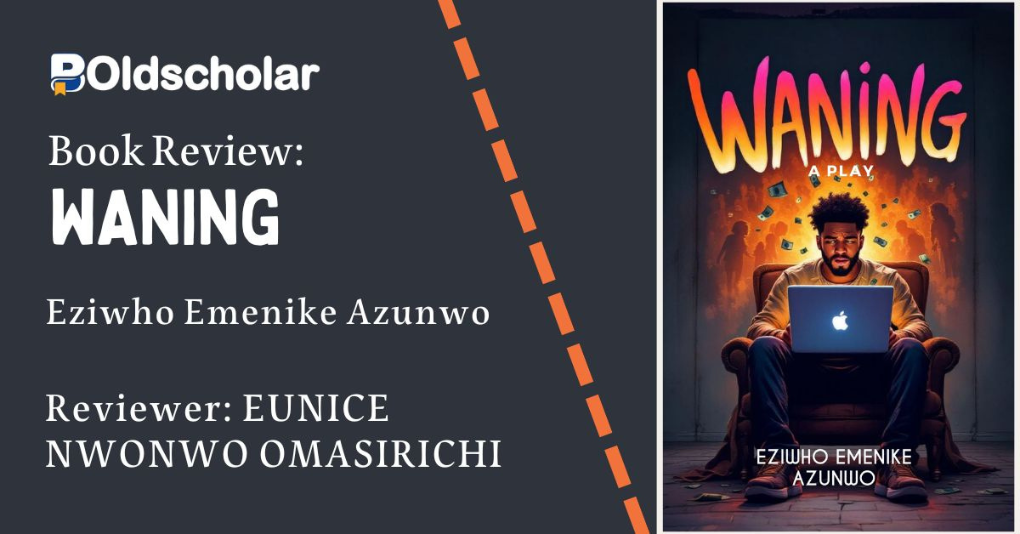Title: Child’s Play
Genre: Play
Author: Eziwho Emenike Azunwo
Year of Publication: 2025
Publisher: Covenant Daystar Publishers, Port Harcourt. Nigeria
Pagination: (Number of pages) 86 pages
Reviewer: Ikenna-Obi Nneka Chigozie
Institution: Rivers State University, Port Harcourt, Department of Theatre and Film Studies
Introduction
Within the corpus of contemporary Nigerian drama, Child’s Play: A Play by Eziwho Emenike Azunwo constitutes a visceral critique of systemic collapse, institutional inertia, and the quiet yet relentless tragedies pervading Nigeria’s educational fabric. Revered in academic and literary circles as The Academic Rabbi, Azunwo wields the stage not simply as a medium for storytelling but as a platform of moral urgency, what may be called a dramaturgy of witnessing, resistance, and lamentation. Published in 2025, the play emerges from a sociopolitical landscape scarred by insecurity, bureaucratic impunity, and the numbing repetition of national grief. As Azunwo poignantly affirms in his Author’s Note, “I did not write this story to entertain, but to awaken” (Azunwo, 2025, p. 6).
Set against the backdrop of a remote Nigerian village, Child’s Play dramatizes an appalling yet all-too-familiar tragedy. Students are compelled to sit for a national examination under torchlight due to infrastructural inadequacies. Their subsequent abduction, alongside a committed teacher, Mrs. Rita, due to a lack of security, underscores the deadly consequences of systemic failure. The deaths that follow expose not only the fragility of human life but a moral order in paralysis. The narrative transcends its literal event—kidnapping—and transforms into an ethical confrontation with a society that, as the playwright bitterly observes, “prioritizes protocol over protection, and procedure over people” (Azunwo, 2025, p. 9).
Child’s Play finds its dramaturgical lineage in the African protest theatre tradition, drawing kinship with the polemical works of Ola Rotimi and Femi Osofisan. Yet, Azunwo injects a heightened sense of immediacy by layering his drama with contemporary Nigerian crises—rampant educational neglect, police extortion, structural complicity, and the haunting vulnerability of children. The opening scene sets this tone vividly: students “burst into energetic step routines,” only to be silenced by the authoritarian figure of the Principal wielding a “long, merciless cane” (Azunwo, 2025, pp. 11–12). This symbolic interplay of youthful energy and institutional repression threads the entire play.
The emotional and moral core of the drama resides in Mrs. Rita, whose quiet defiance and sacrificial courage elevate her to the stature of a tragic heroine. In a harrowing moment of maternal and ethical conviction, she pleads with her captors: “Please, take me instead… she is just a child… do with me whatever you want” (Azunwo, 2025, p. 38). Her death, while deeply personal, functions allegorically—an embodiment of the abandonment of moral virtue, compassion, and pedagogical integrity in a society increasingly defined by neglect.
Azunwo’s critique does not stop at criminal elements. His sharpest barbs are reserved for the institutional gatekeepers—the police, educators, and bureaucrats—whose inefficiencies are laced with transactional corruption. In a telling encounter at the police station, the Vice Principal is bluntly reminded: “Driving that far to Akani… the operational vehicle is not even in great shape—it needs servicing—but it can still manage the journey. At least something can be done about the fuel part” (Azunwo, 2025, p. 60). This moment encapsulates the Kafkaesque absurdity of state operations, where administrative delays and extortion eclipse any urgency for human rescue or justice.
From a stylistic standpoint, Azunwo blends naturalistic dialogue with elegiac lament, choreographed drumming, and community-based rituals, evoking indigenous theatrical traditions. The drummers are not mere background figures but function as a living conscience of the play—punctuating emotional shifts and invoking communal responses to unfolding horrors. In this way, Child’s Play assumes a meta-theatrical function: the stage becomes a tribunal, not just for fictional characters, but for an entire nation whose soul, Azunwo suggests, is on trial.
Ultimately, Child’s Play is a drama of necessity—deeply tragic, politically conscious, and emotionally scalding. It mourns the dead, accuses the apathetic, and compels its audience to reckon with complicity. As the play’s final rhetorical question resounds—“how many lives must be sacrificed before accountability is no longer an afterthought?” (Azunwo, 2025, p. 9)—one realizes that this work is not merely a theatrical script, but a civic document. For educators, scholars, and policy analysts alike, Child’s Play is not just to be studied; it is to be heard, remembered, and acted upon.
Plot Structure
The play begins in a modest rural Nigerian school setting, immediately establishing a stark contrast between youthful vitality and an atmosphere steeped in institutional dread. The opening tableau is rich in sensory imagery and traditional performance elements: “The stage thunders with loud drumming,” as students enter, visibly anxious, “holding notes and textbooks, revising nervously” in anticipation of their national examination (Azunwo, 2025, p. 11). This moment of communal energy and academic hope is swiftly disrupted by the entrance of the Principal, whose presence is symbolically and literally oppressive, emphasized by his grip on a “long, merciless cane” (p. 11). In this abrupt tonal shift, Azunwo begins to unravel the play’s recurring motifs of authority, fear, and institutional violence.
The Principal’s interrogation of students, punctuated by overt intimidation, underscores the deeply rooted culture of coercion and corruption within the educational system. His command—“If you are owing the school—this way. If you are not owing—that way” (p. 14)—lays bare the commodification of learning, where access to education is contingent upon one’s ability to pay, regardless of context. The public shaming of students like Solomon, who is berated for his inability to pay his fees, and Dominic, whose possession of an iPhone draws suspicion and corporal punishment, illustrates a system in which discipline and humiliation have replaced mentorship and empathy. In these exchanges, Azunwo critiques an educational structure driven less by the pursuit of knowledge and more by authoritarian control and economic gatekeeping.
The dramatic intensity heightens in Scene Two with the abrupt and harrowing abduction of Mrs. Rita and five students by armed kidnappers. Azunwo’s stage direction vividly captures the brutality of the moment: “Loud cry and screaming cloud the stage… blood stains and injury marks on the body of Mrs. Rita and five students in captivity” (Azunwo, 2025, p. 33). At this juncture, the narrative shifts from satirical critique to outright tragedy, reflecting the stark realities of school abductions that have increasingly disrupted Nigeria’s educational landscape (Obasi & Oloyede, 2022).
The dialogue of the kidnappers, marked by colloquial expressions and aggressive posturing, reveals a chilling normalization of violence. “We just dey welcome una… una dey shout… what if the real beating start?” (p. 35), one assailant sneers, suggesting that terror has become a routine initiation. Yet Azunwo refrains from portraying these characters as purely villainous. Instead, he situates them within the context of systemic collapse. Man 1 rationalizes their actions as a consequence of societal neglect: “We are only surviving… this is where we’ve found ourselves… in biology, it’s called ecology” (p. 41). This disturbing justification underscores the way broken institutions can create moral ambiguity and nurture violence.
Scene Two intensifies the narrative with the sudden and traumatic abduction of Mrs. Rita and five students by armed kidnappers. This marks a pivotal shift in the play’s trajectory—from grim satire to raw, emotional tragedy. The stage directions immediately convey the brutality of the moment: “Loud cry and screaming cloud the stage… blood stains and injury marks on the body of Mrs. Rita and five students in captivity” (Azunwo, 2025, p. 33). This disturbing scene mirrors the real-world epidemic of school kidnappings that has marred Nigeria’s educational system. As noted by Obasi and Oloyede (2022), “Nigeria’s educational institutions, particularly in rural and semi-urban zones, have become soft targets for insurgents and criminals due to chronic underfunding, poor infrastructure, and inadequate security.”
The language used by the kidnappers, laden with colloquial expressions and threats, underscores the normalization of violence in the society Azunwo portrays. Their intimidation is evident in the line: “We just dey welcome una… una dey shout… what if the real beating start?” (Azunwo, 2025, p. 35). However, Azunwo resists reducing the kidnappers to caricatures of evil. Instead, he presents them as products of a broken system—individuals molded by survivalist logic in a failing state. Man 1 defends their actions with chilling pragmatism: “We are only surviving… this is where we’ve found ourselves… in biology, it’s called ecology” (p. 41). This framing invites the audience to consider the socio-economic structures that give rise to such violence.
Scene Three returns to the school, where the gravity of the abduction begins to unravel the fragile administrative order. The panic and helplessness within the school leadership are vividly portrayed when Mr. Awuse, the husband of Mrs. Rita, confronts the Principal in desperation: “Where will I get 50 million before tomorrow evening to save my wife?” (p. 49). The Principal’s inability to provide a decisive response reflects not only his personal helplessness but also a broader institutional paralysis. His conflicted reaction—caught between bureaucratic duty and human crisis—highlights the systemic dysfunction that Azunwo critiques throughout the play.
Scene Three turns the spotlight to the institutional response—or lack thereof—as news of the abduction sends waves of confusion through the school. The emotional core of the scene is embodied in Mr. Awuse, Mrs. Rita’s husband, whose frantic outburst encapsulates the hopelessness of ordinary citizens in the face of such crises: “Where will I get 50 million before tomorrow evening to save my wife?” (p. 49). The Principal, overwhelmed and indecisive, embodies the broader paralysis of leadership, unable to navigate the thin line between administrative obligation and human urgency. Through this portrayal, Azunwo lays bare a critical commentary on leadership inertia in moments of national emergency.
Character and Characterization
In Child’s Play, Eziwho Emenike Azunwo constructs a range of vivid, symbolically charged characters who represent the complex layers of Nigerian society—its contradictions, crises, and conscience. Through the play’s key figures, Azunwo delivers a penetrating critique of institutional decay, while offering moments of resistance, resilience, and sacrifice. The characters are not merely individuals but embodiments of broader social roles and tensions. Their development is driven not only through dialogue but through gestures, silences, and interactions with oppressive systems.
Mrs. Rita – The Moral and Emotional Core
Mrs. Rita stands as the heart of the play—an embodiment of sacrifice, moral conviction, and maternal love. A committed teacher and mother, she is the only adult character whose actions reflect selflessness and integrity. Even in captivity, bleeding and bruised, she exudes strength. In one of the play’s most harrowing scenes, she begs the kidnappers to take her life instead of harming a female student:
“Please, take me instead… she is just a child… do with me whatever you want” (Azunwo, 2025, p. 38).
This moment cements her role as a Christ-like figure, whose death is both literal and symbolic—a sacrifice that indicts a society that fails to protect its moral anchors. Her resistance is quiet, grounded in empathy rather than confrontation. She also reflects a tragic irony: the very system she served devoutly fails her in her moment of need.
Furthermore, her educational background and rational demeanor are emphasized when she responds to her captors’ reasoning with reason of her own:
“I’m a mother… and I know she is not due for what you want to do to her… please take me instead” (p. 38).
Her characterization evokes the archetype of the teacher as nurturer, martyr, and ultimately, a casualty of national neglect.
The Principal – The Face of Institutional Hypocrisy
The Principal is one of the most complex characters in the play. On the surface, he appears committed to order and discipline, but beneath that lies deep hypocrisy and opportunism. He is introduced wielding “a long, merciless cane” (p. 11), a symbol of the authoritarian structure he upholds.
His interactions with students such as Solomon and Dominic expose his exploitative tendencies. When Dominic is found with an iPhone, the Principal responds sarcastically and abusively:
“Your principal is using a Tecno phone, and you’re using an iPhone 15 Pro. And you can’t even sow a seed into my life?” (p. 25).
He is more concerned with asserting dominance and collecting debts than with the welfare of the students. Yet, when tragedy strikes, he is overwhelmed and directionless, unable to act decisively:
“I don’t even know how to explain this…” (p. 53).
The Principal’s duality—public firmness versus private helplessness—makes him a symbol of failed leadership in Nigerian institutions: vocal in routine matters, paralyzed in times of crisis.
Mr. Tom – The Outsider’s Cynical Eye
Mr. Tom, the external NECO examiner, brings a fresh but cynical perspective. As someone sent from the city, he is immediately concerned about his own safety rather than the educational mission. His sharp commentary exposes the absurdity of the system:
“I came here on an examination assignment… not suicide assignment… I have a wife and three children at home” (p. 77).
He often functions as the audience’s voice within the play, drawing attention to the abnormality of students writing exams in the night by torchlight:
“Look at these students… writing a national exam with torch lights and no adequate provision…” (p. 78).
Though not heroic, Mr. Tom’s disillusionment highlights how unlivable the system has become, even to those who function within it.
Mr. Awuse – The Human Cost of Negligence
As the husband of Mrs. Rita, Mr. Awuse’s character is defined by anguish and helplessness. His breakdown in Scene Three captures the emotional toll of systemic failure:
“Where will I get 50 million before tomorrow evening to save my wife?” (p. 49).
He is one of the few characters who verbalize the frustration of the powerless:
“Please teach me calmness… please…” (p. 51).
Mr. Awuse does not drive the plot, but his grief embodies the pain endured by ordinary Nigerians who bear the brunt of broken systems. His presence reinforces the domestic dimension of the tragedy—one that moves beyond headlines to homes.
The Kidnappers – Products of a Broken Ecology
The kidnappers, though antagonists, are not demonized. Azunwo presents them as grim consequences of state failure. Man 1 offers a disturbingly rational explanation for their actions:
“We know what we’re doing is bad, but this is the only way to survive… and this is where we’ve found ourselves… in biology, it’s called ecology” (p. 41).
Their speech, often laced with street slang and threats, reflects the normalized brutality they inhabit:
“We just dey welcome una… una dey shout… what if the real beating start?” (p. 35).
By humanizing their desperation while critiquing their violence, Azunwo raises difficult questions about blame, survival, and societal neglect.
Students – Innocence Trapped in a Violent System
The students, including Solomon, Grace, Dominic, and Mercy, are portrayed as victims—young people caught between hope and horror. Their early scenes are marked by anxiety, obedience, and academic aspiration. As the play progresses, they become voiceless witnesses and recipients of systemic violence.
The student who dies in captivity is denied even the dignity of care:
“He was asking for water and then started coughing… and all I heard was him vomiting blood…” (Mrs. Rita, p. 70).
Mercy’s later collapse during the exam, after the ordeal, is both literal and symbolic—her fainting underlines how the system fails even the survivors:
“She needs to be rushed to the hospital.”
“There are no hospitals here and I think the health center only opens twice a week…” (pp. 81–82).
The students’ characterization reinforces the central theme of vulnerable youth sacrificed to a dysfunctional order.
Azunwo’s Child’s Play crafts characters who are simultaneously symbolic and deeply human. Through Mrs. Rita’s martyrdom, the Principal’s duplicity, Mr. Tom’s disillusionment, and the students’ suffering, the playwright dissects the layers of a failing educational and political ecosystem. The characters are not merely tools of the plot—they are reflections of a fractured nation where morality, leadership, and innocence are all under siege. Their interactions, shaped by fear, silence, and fleeting resistance, bring Azunwo’s indictment of Nigeria’s systemic collapse into sharp, unforgettable focus.
Thematic Concerns in Child’s Play
Eziwho Emenike Azunwo’s Child’s Play is thematically rich, engaging with pressing national issues through a blend of realism, satire, and emotional gravitas. The play unpacks the fragile state of Nigeria’s education system and the larger failures of governance, weaving in themes of institutional decay, sacrifice, systemic violence, and societal silence. These themes are expressed through character actions, dialogue, and the symbolic use of space and time—particularly the choice to set a national examination in a rural school with no security, power, or medical infrastructure.
Educational Neglect and Institutional Failure
At the heart of Child’s Play is the critique of Nigeria’s failing educational institutions. The play’s setting—a poorly equipped school in a rural community—immediately establishes this theme. Students are made to write a high-stakes national exam under precarious conditions, literally in the dark. As Mr. Tom observes with disbelief:
“Look at these students… writing a national exam with torch lights and no adequate provision…” (Azunwo, 2025, p. 78).
The Principal, instead of acting as a custodian of learning, becomes a symbol of exploitation. His obsession with school fees and discipline overshadows concern for student welfare. In an early scene, he shames Solomon for unpaid fees:
“If you are owing the school—this way. If you are not owing—that way” (p. 14).
These depictions reveal how access to education has become transactional, compromised by corruption and poor policy execution.
Sacrifice and the Failure to Protect Caregivers
The theme of sacrifice is powerfully embodied in the character of Mrs. Rita, the compassionate teacher who lays down her life to protect a student. In one of the play’s most moving lines, she pleads with her captors:
“Please, take me instead… she is just a child… do with me whatever you want” (p. 38).
Her willingness to offer herself underscores the moral courage absent in the state’s response to the crisis. Mrs. Rita’s death becomes a tragic symbol of the vulnerability of educators—those expected to nurture the future, yet abandoned in their moment of need. The tragedy is compounded when Mr. Awuse laments:
“Where will I get 50 million before tomorrow evening to save my wife?” (p. 49).
Azunwo uses her death to indict a society that has lost the capacity to value and protect its most selfless citizens.
Violence, Trauma, and the Normalization of Insecurity
Violence is not only a plot device in Child’s Play, but a recurring thematic motif that permeates every layer of society depicted in the play. From corporal punishment in school to fatal kidnappings, violence is normalized and even bureaucratized.
The kidnappers are disturbingly self-aware. Man 1 explains:
“We are only surviving… this is where we’ve found ourselves… in biology, it’s called ecology” (p. 41).
Their rationalization of crime as a survival mechanism reflects the failures of socio-economic policies and youth disempowerment. Meanwhile, students are not spared from this trauma. One student dies in captivity due to medical neglect:
“He was asking for water and then started coughing… and all I heard was him vomiting blood…” (Mrs. Rita, p. 69/70).
Such harrowing details emphasize that trauma is no longer exceptional in Nigeria’s reality—it is expected, and its victims are forgotten.
Bureaucratic Indifference and Corruption
The failure of institutions is not merely due to incompetence, but active indifference and corruption. The police, instead of responding to the emergency with urgency, demand logistical compensation before action. The DPO states plainly:
“Driving that far to Akani… the operational vehicle is not even in great shape—it needs servicing—but it can still manage the journey. At least something can be done about the fuel part” (p. 60).
Such transactional justice delays any meaningful response to the crisis and underscores the rot within public service delivery. The Vice Principal’s disbelief is met with cold pragmatism—fuel and food for action, or nothing gets done. In this world, bureaucracy is not a neutral system, but a barrier that costs lives.
Silence, Complicity, and the Failure of Collective Responsibility
Azunwo does not only blame the institutions or criminals; he also implicates the larger society in a culture of silence. Many characters know the system is broken but choose to adapt rather than resist. The Principal represents this resigned complicity, choosing to maintain order even when students are kidnapped. Mr. Tom, though critical, eventually opts for withdrawal rather than engagement:
“As for me… this is reckless… I’m done” (p. 86).
This resignation mirrors what Eluwa (2019) describes as “the politics of non-confrontation” in Nigerian political drama, where silence becomes a tool of survival and complicity.
Collapse of Leadership and Moral Paralysis
Leadership in Child’s Play is defined by indecision, blame-shifting, and moral cowardice. The Principal, who holds authority within the school, is paralyzed when confronted with a real crisis:
“I don’t even know how to explain this…” (p. 53).
Similarly, the police inspector’s nonchalant tone—“Have the police refused to help you?” (p. 60)—illustrates a bureaucracy that deflects accountability.
Azunwo frames leadership not merely as incompetent, but ethically hollow. In a play filled with cries for help, no meaningful action comes from those in power.
Youth and Lost Futures
The students in Child’s Play symbolize Nigeria’s next generation—anxious, oppressed, and sacrificed on the altar of institutional neglect. Their early attempts to study and engage the examiner reflect genuine effort and hope. But this is gradually stripped away by humiliation, fear, and death. By the final scene, Mercy collapses from exhaustion:
“She has fainted oh… She needs to be rushed to the hospital.”
“There are no hospitals here and I think the health center only opens twice a week…” (pp. 81–82).
This theme of lost futures reinforces the central tragedy: it is not only individuals who die in Child’s Play, but the promise of tomorrow itself.
Conclusion
Eziwho Emenike Azunwo’s Child’s Play transcends the boundaries of conventional drama; it is a profoundly ethical narrative, a powerful socio-political lament, and a cultural exposé articulated through the performative lens of theatre. Rooted in the harrowing realities of Nigeria’s failing educational system, the play reimagines the stage as a space of confrontation—where systemic neglect, exploitation, and collective silence are laid bare for public reckoning. From the emotionally wrenching death of Mrs. Rita, who offers her life in place of her student’s, to the biting depiction of a bureaucracy that demands bribes before intervention, Child’s Play reflects the tragic entanglement of a nation ensnared in institutional decay.
The play’s structural rhythm—shifting from the vibrant pulse of school drumming to the somber aftermath of death—mirrors both psychological fragmentation and the erosion of public trust in state institutions. Azunwo resists the temptation to offer superficial resolutions; instead, he places responsibility squarely at the feet of society. His cast of characters—whether resilient or complicit—are emblematic of the multiple layers of contemporary Nigerian existence: the selfless teacher, the grieving spouse, the corrupt school head, the disillusioned education officer, the transactional police, and the emotionally scarred students. Together, they embody the devastating consequences of a system that elevates protocol over compassion and regulation over the protection of life.
By integrating the sonic and communal elements of African performance—drumming, collective chanting, reflective silences, and ritual lamentation—Azunwo draws deeply from indigenous theatrical aesthetics to give form to modern political critique. His fusion of satire, grief, and realism not only exposes national dysfunction but also calls forth a deeply felt moral response. As the playwright warns:
“Don’t let this be just another tale told in passing. Let it stir you. Let it haunt you. Let it move you…” (Azunwo, 2025, p. 7).
In that moment, the audience is no longer a passive witness but a participant, summoned to reflection and action.
Ultimately, Child’s Play is a necessary tragedy—one that documents the fragility of hope, the collapse of leadership, and the repeated sacrifice of the innocent. It asks its central question with unrelenting clarity:
“How many lives must be sacrificed before accountability is no longer an afterthought?” (p. 9).
For scholars, educators, theatre practitioners, and policy stakeholders, this play is not simply to be read—it is to be reckoned with. It is a call to confront the normalized dysfunctions in our educational and political systems and to remember, through theatre, the names and voices often lost in silence.
References
Azunwo, E. E. (2025). Child’s play: A play. Port Harcourt: Covenant Daystar Publishers.
Eluwa, M. C. (2019). Silence as complicity: The politics of non-confrontation in Nigerian political drama. Journal of African Performance Studies, 11(2), 45–59.
Fanon, F. (1961). The wretched of the earth (C. Farrington, Trans.). New York, NY: Grove Press.
Igweonu, K. (2007). Trends in Nigerian theatre and drama. Newcastle, UK: Cambridge Scholars Publishing.
Obasi, C., & Oloyede, T. (2022). Security and the crisis of access in Nigerian schools. African Journal of Educational Studies, 18(1), 77–93.
Soyinka, W. (1988). Art, dialogue, and outrage: Essays on literature and culture. Ibadan: New Horn Press.
Share this post





Be the first to comment on this post